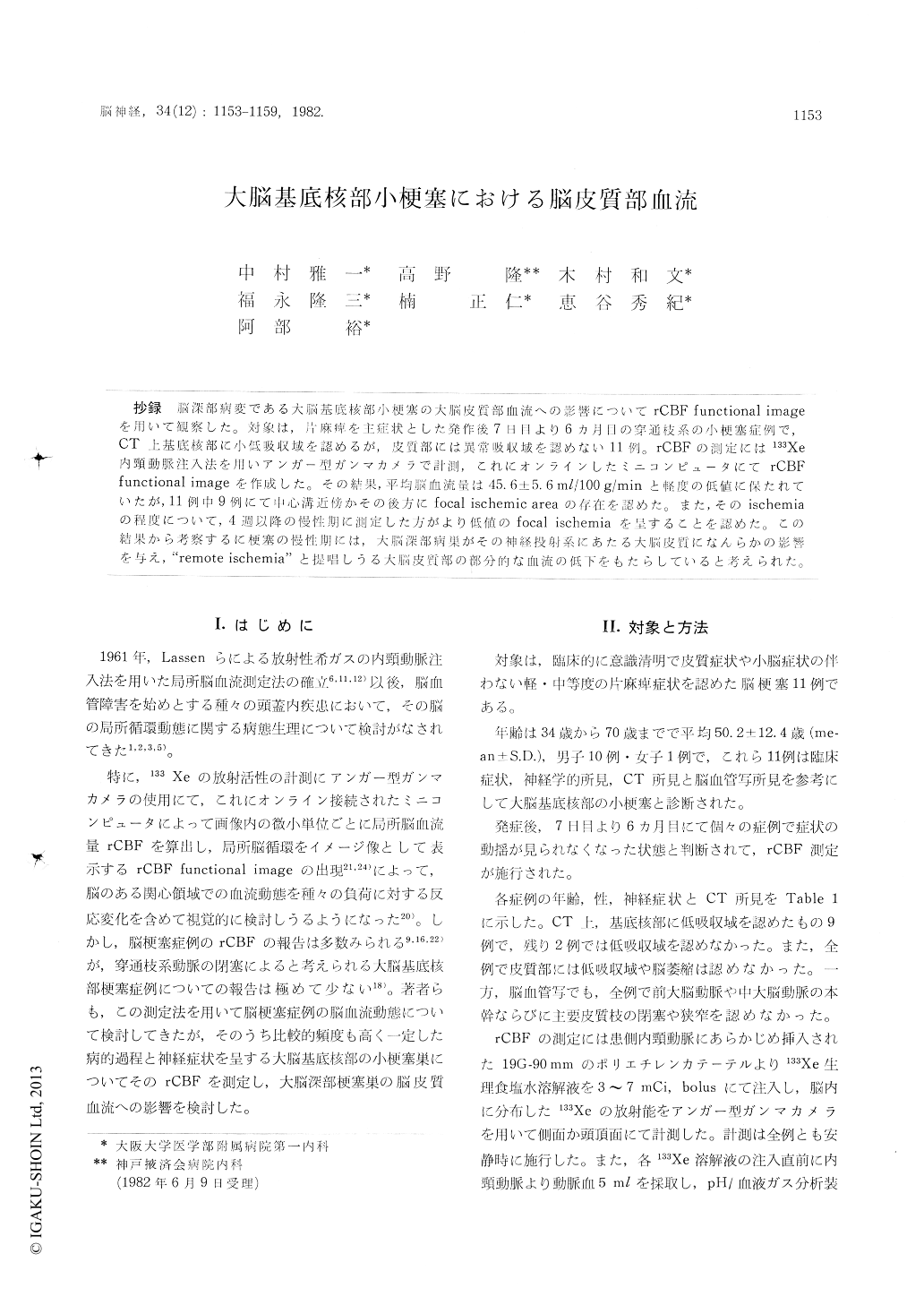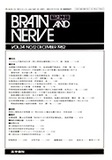Japanese
English
- 有料閲覧
- Abstract 文献概要
- 1ページ目 Look Inside
抄録 脳深部病変である大脳基底核部小梗塞の大脳皮質部血流への影響についてrCBF functional imageを用いて観察した。対象は,片麻痺を主症状とした発作後7日目より6カ月目の穿通枝系の小梗塞症例で,CT上基底核部に小低吸収域を認めるが,皮質部には異常吸収域を認めない11例。rCBFの測定には133Xe内頸動脈注入法を用いアンガー型ガンマカメラで計測,これにオンラインしたミニコンピュータにてrCBFfunctional imageを作成した。その結果,平均脳血流量は45.6±5.6ml/100g/minと軽度の低値に保たれていたが,11例中9例にて中心溝近傍かその後方にfocal ischemic areaの存在を認めた。また,そのischemiaの程度について,4週以降の慢性期に測定した方がより低値のfocal ischemiaを呈することを認めた。この結果から考察するに梗塞の慢性期には,大脳深部病巣がその神経投射系にあたる大脳皮質になんらかの影響を与え,"remote ischemia"と提唱しうる大脳皮質部の部分的な血流の低下をもたらしていると考えられた。
Since the introduction of rCBF measurement, pathophysiological studies have been made relating to the regional cerebral circulation in cerebrovas-cular disorders. But, most subjects in those stu-dies were patients with larger infarction, such as MCA stenosis or occlusion. While, few studies have been done relating to the small deep hemi-spheric infarction without involvement of cortical regions. The purpose of this study is to investi-gate the influence of small deep hemispheric infar-ction on rCBF functional image at rest. Eleven patients aged 34-70 years (average 50.2±12. 4years) were studied, all with small deep hemispheric infarction in the subacute or chronic stage of apo-plexy. The group constituted a consecutive series of patients fullfilling the following criteria ; 1 ) CT : a small hemispheric infarction in the territory of a penetrating vessel, such as lenticulostriate arteries. 2) Angiography: no abnormality of ma-jor intracranial arteries. 3) Consciousness : clear-ness. 4) Neurological signs: hemiparesis and no cortical signs. The rCBF measurement was made by the Xe-133 clearance method. Shortly, 3-7 mCi of Xe-133 in saline was injected rapidly through a catheter into the internal carotid artery, and the data of dynamic images of Xe-133 were mea-sured for 130 sec by a gamma camera placed over a lateral or vertex aspect of a patient's head. The rCBF was calculated by the initial slope method and the rCBF functional image was obtained by means of the on-line minicomputer system. The blood flow is shown in absolute value and percent of the hemispheric mean flow (relative flow).
As a result, the average value of mean rCBF was 45. 6±5. 4 m//100 g/min in all cases (Pacoz: 40. 2±4. 5 mmHg). In nine of the eleven cases, the rCBF functional image showed a focal ischemic area near the central sulcus, where the rCBF was reduced 15% below of the mean rCBF. In nine cases with a focal ischemic area, they were devid-ed into two groups according to the duration of symptoms at the measurement. One was subacutestage group (Case 1~5) less than 3 weeks, ano-ther was chronic stage group (Case 6~11) more than 4 weeks. The blood flow in focal ischemic areas was reduced significantly more in chronic stage group than in subacute stage group (p<0.05). In this study, the rCBF functional image showed the focal ischemic area near the central sulcus in nine of the eleven cases, and the result suggests that the small deep hemispheric infarc-tion has something to influence the cerebral cor-tical circulation. And the "focal ischemic area" was shown not only in the acute stage of large/ infarction but also in the chronic stage of small deep hemispheric infarction. Because of those evi-dences, these focal areas seem to be not induced by only vasomotor paralysis or secondary cerebra] edema. These findings are probably due to the fact that small deep hemispheric infarctions, such as infarction in the basal ganglia, may create "re-mote" cortical circulation and metabolic changes by transneural depression in the cortical corres-ponding areas to the neurological pathway. The remote effect, that is a kind of "diaschisis", may be propagated by corticospinal projections.

Copyright © 1982, Igaku-Shoin Ltd. All rights reserved.


